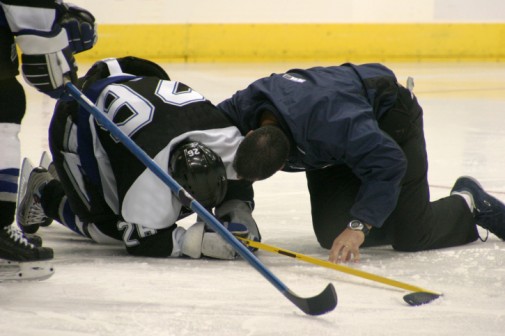How concussion laws are changing the sports landscape

There has been a 92 percent increase in the number of children, ages 12-18 years old, seeking medical treatment for concussion-related injuries, since the inception of concussion laws. That’s according to a recent study at the University of Michigan. All 50 states including the District of Columbia have enacted concussion laws regulating concussion treatment.
“It is great to see the increased awareness,” says Dr. David Lessman, pediatric sports medicine at Advocate Children’s Hospital in Park Ridge, Ill. “Our Concussion Program, and others like it, are aimed at making sure student athletes are getting appropriate care for their head injuries.”
A concussion is an injury to the brain caused by a blow to the head or body. The symptoms can range from subtle to obvious and can sometimes take days to manifest.
“That’s why we must continue to educate coaches and parents about the symptoms of a concussion,” adds Dr. Lessman. “It is critical that athletes with head injuries are assessed, diagnosed and monitored appropriately.”
The Illinois law, passed in July of 2011, outlines these four steps to ensure students receive appropriate attention for head injuries.
- School boards work with the Illinois High School Association (IHSA) to educate coaches, athletes and parents about concussions.
- Athletes are given an information sheet about concussions that must be signed before participation in a sport.
- Athletes suspected of having a concussion are removed from play immediately.
- Athletes cannot return to play until evaluated by a licensed health care provider trained in the evaluation and management of concussions and head injuries, who gives written clearance to return.
“I advise all parents to err on the side of caution,” says Dr. Lessman. “If your child has a head injury and is showing symptoms, it is always best to seek medical treatment.”
Related Posts
Comments
3 Comments
About the Author
Evonne Woloshyn, health enews contributor, is director of public affairs at Advocate Children's Hospital. Evonne began her career as an anchor and reporter in broadcast news. Over the past 20 years, she has worked in health care marketing in both Ohio and Illinois. Evonne loves to travel, spend time with family and is an avid Pittsburgh Steelers fan!


















While ice hockey receives a dubious rap for frequency of concussions, the Chicago Blackhawks have partnered with Athletico and the North Shore health system to pay for concussion base line testing for all youth hockey players in the Chicago area. So while the program does not prevent young athletes from getting concussions, it does start the process for determining when a concussion has occurred. It give parents the information they need to err on the side of caution.
My girls play soccer which is a sport with A LOT of concussions because of headers. I purchased concussion bands for my girls as did other parents on the team — unfortunately, we all have a tough time trying to get the girls to wear them and isn’t a requirement at our school. However, our school always plays Francis Parker High School for soccer and it is a requirement for their players to wear concussion bands. Interestingly, a couple of years ago, one of the Francis Parker players was Gary Fencik’s daughter, and he took an active role in concussion education at the school.
Hopefully this new law helps reduce the frequency of concussions!